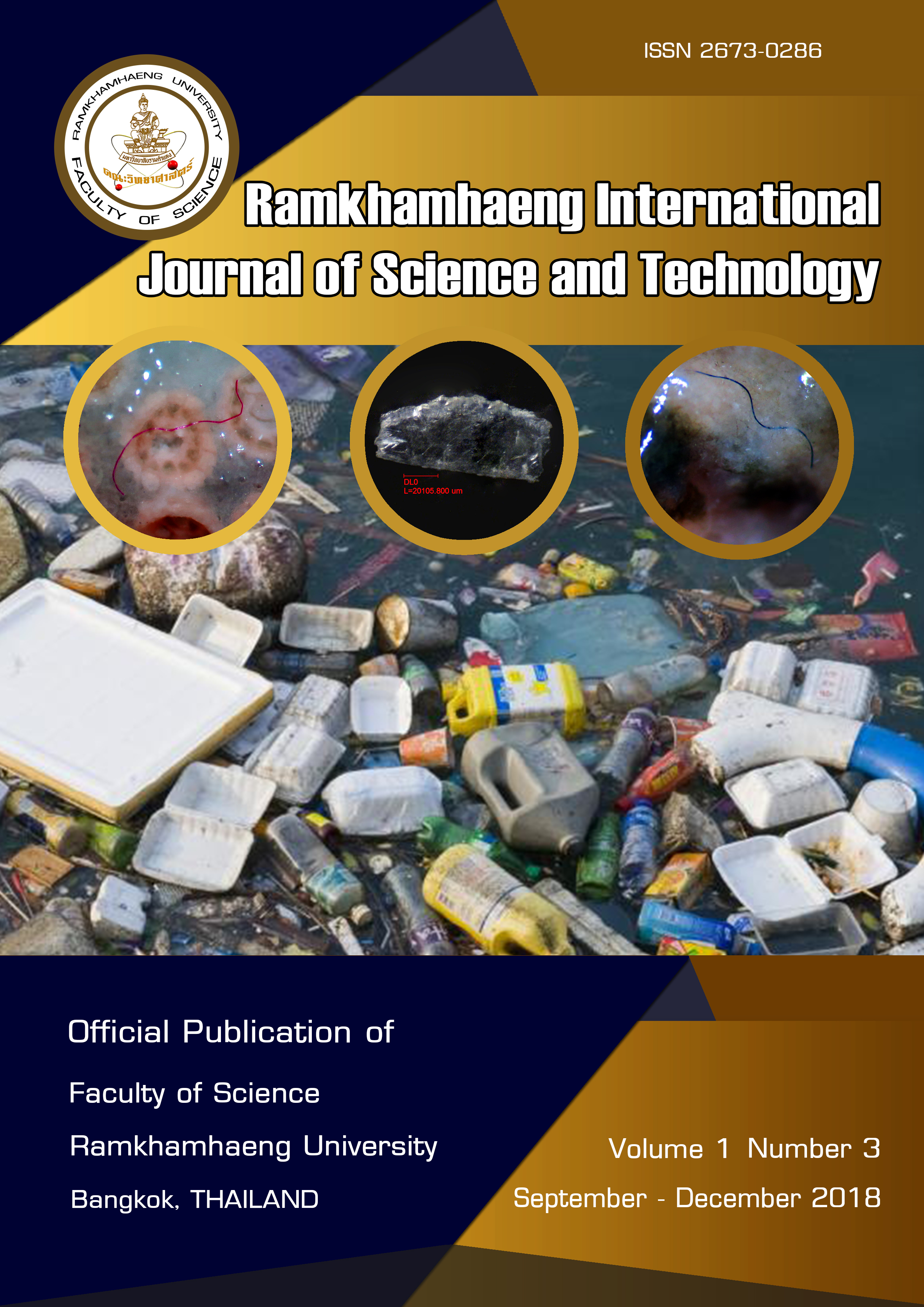Microplastics in the digestive tracts of reef fish in the Eastern Gulf of Thailand
Keywords:
microplastics, fish, coral reef, pollution, Gulf of ThailandAbstract
Plastic use and disposal have increased as a consequence of industrial development in most countries, resulting in plastic pollution in marine and coastal ecosystems. Several studies reported plastic ingestion by sea turtles, seabirds and marine mammals, however much less is known about the consumption of plastic debris by marine fishes, particularly in Thai waters. The aim of this study was to analyze the abundance of microplastics in gut contents of reef fishes in Trat Province, the Eastern Gulf of Thailand. The reef fishes were collected using fish traps during January – October in 2016. The stomachs of the fishes were removed, opened and then the contents were rinsed into vials. The abundance of microplastics in the fish was examined by hydrogen peroxide and floatation then filtration with saline (NaCl) solution treatments. A total of 17 reef fish species were collected. The most abundant species were Siganus canaliculatus, Sargocentron rubrum, and Lutjanus russellii. The microplastic sizes ranged between 500 and 4,000 µm. the highest abundance of microplastics was found in Siganus canaliculatus, while the lowest abundance levels were observed in Sargocentron rubrum and Lutjanus russellii. Most microplastics were blue and colorless fibers. This study highlights the importance of public awareness regarding microplastic pollution in coastal and marine ecosystems.
References
Arthur C, Baker JE, Bamford HA (2008) Proceedings of the International Research Workshop on the Occurrence, Effects, and Fate of Microplastic Marine Debris, NOAA Technical, Memorandum. Ed.
Avio CG, Gorbi S, Regoli F (2015) Experimental development of a new protocol for extraction and characterization of microplastics in fish tissues: first observations in commercial species from Adriatic Sea. Marine Environmental Research 111: 18–26.
Bellas J, Martínez-Armental J, Martínez-Cámara A, Besada V, Martínez-Gómez C (2016) Ingestion of microplastics by demersal fish from the Spanish Atlantic and Mediterranean coasts. Marine Pollution Bulletin 109: 55–60.
Boerger CM, Lattin GL, Moore SL, Moore CJ (2010) Plastic ingestion by planktivorous fishes in the North Pacific Central Gyre. Marine Pollution Bulletin 60: 2275–2278.
Eriksen M, Maximenko N, Thiel M, Cummins A, Lattin G, Wilson S, Hafner J, Zellers A, Rifman S (2013) Plastic pollution in the South Pacific subtropical gyre. Marine Pollution Bulletin 68: 71–76.
Ferreira GV, Barletta M, Lima AR, Morley S A, Justino AK, Costa MF (2018) High intake rates of microplastics in a Western Atlantic predatory fish, and insights of a direct fishery effect. Environmental Pollution 236: 706-717.
Frias JPGL, Gago J, Otero V, Sobral P (2016) Microplastics in coastal sediments from Southern Portuguese shelf waters. Marine Environmental Research 114: 24–30.
Fox RJ, Bellwood DR (2008) Remote video bioassays reveal the potential feeding impact of the rabbitfish Siganus canaliculatus (f: Siganidae) on an inner-shelf reef of the Great Barrier Reef. Coral Reefs 27: 605–615.
Golani D, Ben-Tuvia A, Galil B (1983) Feeding habits of the Suez Canal migrant squirrelfish, Sargocentron rubrum, in the Mediterranean Sea. Israel Journal of Zoology 32: 194–204.
Güven O, Gökdağ K, Jovanović B, & Kıdeyş AE (2017) Microplastic litter composition of the Turkish territorial waters of the Mediterranean Sea, and its occurrence in the gastrointestinal tract of fish. Environmental pollution 223: 286-294.
Hajisamae S, Yeesin P, Ibrahim S (2006) Feeding ecology of two sillaginid fishes and trophic interrelations with other co-existing speciesin the southern part of South China Sea. Environmental Biology of Fishes 76: 167–176.
Jambeck JR; Geyer R; Wilcox C; Siegler TR; Perryman M; Andrady A; Narayan R; Law KL (2015). Plastic waste inputs from land into the ocean. Science 347: 768–771.
Lazar B, Gracan R (2011) Ingestion of marine debris by loggerhead sea turtles, Caretta caretta, in the Adriatic Sea. Marine Pollution Bulletin 62: 43–47.
Maes T, Van der Muelen MD, Devriese LI, Leslie HA, Huvet A, Frère L, Robbens J, Vethaak AD (2017) Microplastics baseline surveys at the water surface and in sediments of the North-East Atlantic. Frontiers in Marine Science 4: 1–13.
Neves D, Sobral P, Ferreira JL, Pereira T (2015) Ingestion of microplastics by commercial fish off the Portuguese coast. Marine Pollution Bulletin 101: 119–126.
PlasticsEurope (2017) Plastics - the facts 2017 An Analysis of European Latest Plastics Production, Demand and Waste Data (Brussels: Plastics Europe) https://www.plasticseurope.org/en/resources/publications/274-plastics-facts-2017
Richards ZT, Beger M (2011) A quantification of the standing stock of macro-debris in Majuro lagoon and its effect on hard coral communities. Marine Pollution Bulletin 62: 1693–1701.
Sale PF (Ed) The Ecology of Fishes on Coral Reefs. Academic Press, San Diego, pp. 67–178.
van Sebille E, Wilcox C, Lebreton L, Maximenko N, Hardesty BD, van Franeker JA, Eriksen M, Siegel D, Galgani F, Law KL (2015) A global inventory of small floating plastic debris. Environmental Research Letters 10: 124006.
Downloads
Published
Issue
Section
License
Copyright Notice: a copyright on any article in the published journal is retained by the Ramkhamhaeng International Journal of Science and Technology. Readers or Users grant the right to use of the Article contained in the Content in accordance with the Creative Commons CC BY-NC-ND license and the Data contained in the Content in accordance with the Creative Commons CC BY-NC-ND.



